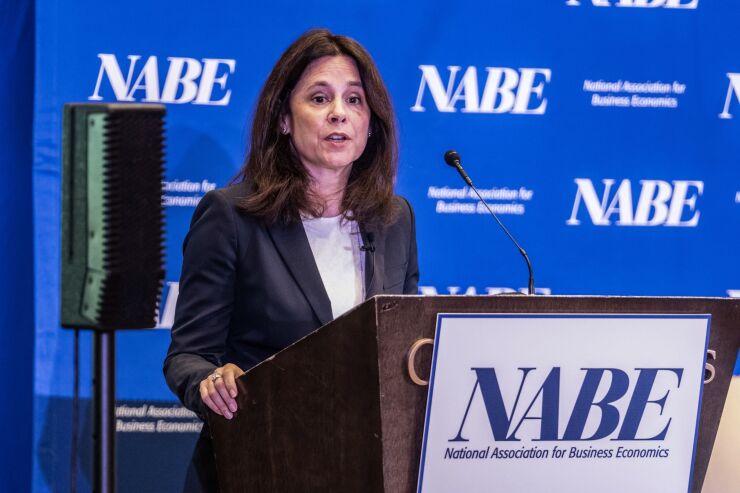
A top Federal Reserve official wants the Federal Open Market Committee to start thinking about slowing down its
Lorie Logan, president of the Federal Reserve Bank of Dallas, discussed the Fed's effort to shrink its holdings during a public speech on Saturday, noting that the Fed's current pace of reduction — $95 billion of securities a month — is roughly double the pace of its
Logan said the
"So, given the rapid decline of the ON RRP, I think it's appropriate to consider the parameters that will guide a decision to slow the runoff of our assets," she said. "In my view, we should slow the pace of runoff as ON RRP balances approach a low level."
Logan pointed to recent fluctuations in the Secured Overnight Funding Rate, or SOFR — an interest rate benchmark derived from spreads in overnight repurchase activity in Treasury securities — as a sign that reserves may be becoming scarce for some banks.
While SOFR rates typically come in higher than the ON RRP rate, the spread between the two widened noticeably at the end of November and again at the end of December, by roughly one-tenth of a percentage point — indicating a slight uptick in borrowing demand by banks. This type of movement is not out of the ordinary, as banks often adjust their books at the end of months, quarters and years. But such spreads were smaller and less frequent during earlier stages of the QT process, according to Fed data.
"The emergence of typical month-end pressures suggests we're no longer in a regime where liquidity is super abundant and always in excess supply for everyone," Logan said in her remarks.
Before taking the top spot at the Dallas Fed in 2022, Logan oversaw the Fed's securities activities as the manager of the System Open Market Account during her tenure as vice president of the New York Fed. Her comments over the weekend echo

A slower approach to QT could have long-term benefits in normalizing the Fed's balance sheet, Logan said, by "smoothing" the redistribution of liquidity in the financial system and thus limiting the likelihood that the Fed would have to cut its reduction plan short.
The Fed reduces its balance sheet by allowing Treasuries and mortgage-backed securities to mature without replacing them. This loss of assets is matched by falling government liabilities — including reserves, ON RRP, the Treasury's general account and cash in circulation, among others. The Fed has shrunk its balance sheet by roughly $1.3 trillion
Throughout the process, Fed officials have pointed to the ON RRP as a buffer against reserve scarcity. Little used since its creation in 2013, the facility — which allows money market funds and other nonbank counterparties to get paid interest for parking assets at the Fed overnight — ballooned in 2021, eventually rising to $2.5 trillion at the end of 2022. Logan and
Since the start of the new year, ON RRP usage has hovered around $700 billion daily. Also, as Logan noted in her speech, a recent survey of senior financial officers indicates that most banks have more than the minimum amount of reserves they need to do business comfortably. Still, she cautioned that ON RRP usage and the amount of excess reserves are not a one-for-one measure and reserves are not distributed equally within the banking system.
"While the current level of ON RRP balances provides comfort that liquidity is ample in aggregate, there will be more uncertainty about aggregate liquidity conditions as ON RRP balances approach zero," she said.





